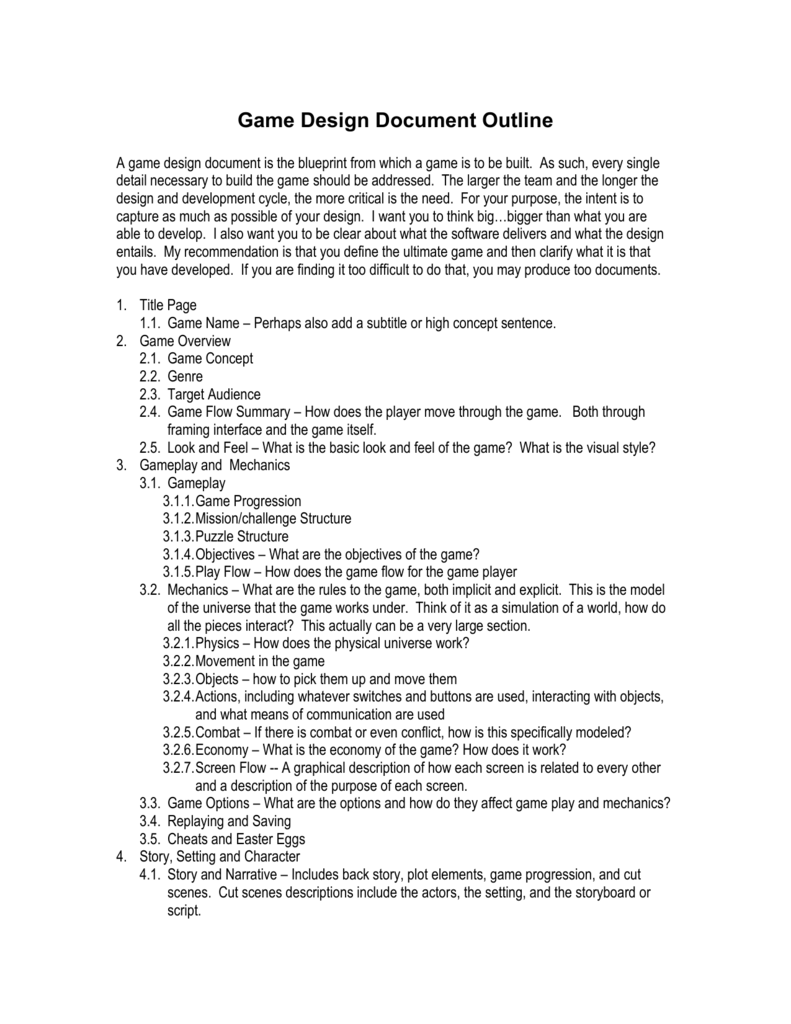Table Of Content

After all, the GDD serves as a reference point, so-called, roadmap for the entire team. Even though this is a guide for writing useful GDDs, that doesn't mean that every team or every designer has use for them, and that's good to know going in. If you are creating a narrative-driven game, you might also consider our resource on free tools for creating story-based games.
Examples of Game Design Documents
We reached out to game designers and developers to weigh in on whether they use GDDs professionally or in their personal work. The most common advice was not to fall prey to any one format if it doesn't clearly communicate what you, the designer, are trying to. This section should introduce and explain the general flow of your game. Start with a core game loop diagram with brief descriptions explaining each of the features and demonstrating how the player will interact with the game. It can be helpful to include a game screen mock-up to support your ideas.
How To Write A Game Design Document?
The point of a basic game design document like this is that it’s simple and easy to use. If you’re an experienced game designer, you could predict the approximate time and budget that the project will require. These estimates should be made when all the other parts of GDD are detailed, as those details will affect the time and budget required. We tried to give you an expert idea of how to make a game design document that corresponds to requirements for GDD to serve as a roadmap for the team and a reference for stakeholders. It keeps the team aligned, ensures clear communication, and is a crucial reference point throughout game-building. Neglecting to have a GDD for a large project can lead to frequent changes, a disorganized development framework, unfulfilled producer expectations, and various other negative impacts on the game development process.
Who reads the GDD?
This means that due to the fluid and flexible nature of the game industry, it will see many changes before the production is over. This organization is crucial for the document’s readability and ensures that all the important elements of the game design are adequately covered. Maintaining consistency with a game’s theme and art style is crucial in UI design as it promotes visual harmony and cultivates a feeling of unity and recognition across the game.
Even if it is just rough and ready, visuals can give a sense of who these people are, how they go about their lives and how they relate to one another over the course of the game's events. In platformers like Super Mario Bros, running and jumping are core mechanics. In most first person shooters, traversing terrain and shooting enemies are mechanics. In almost all visual novels, choosing options from dialogue trees is a main mechanic. You may also want to include sales goals, target demographics, or goals for the game as an expression of your ideas. What do you want to accomplish with this game as a piece of art, cultural artifact, or commercial project?
Project Or Game Description
Because iteration is a healthy, natural and required part of the game development process, things that hold back iteration are generally best skipped. The core gameplay section should summarize what core gameplay is, how it's presented to the player, and the format of gameplay; such as distinct levels, an open world, sandbox sessions, or other formats. This section is important because it helps you create metaphors with which to describe and plan development. Just like people, characters are made up of their past experiences, goals, and aspirations. Next, start to visualize the look of your character with sketches and reference imagery.
In this scenario, it can help to think of your GDD as more of a project pitch or business proposal, as that’s pretty much what it’d be. For that reason, it’s generally a good idea to focus on what you know you can deliver, based on your experience, your skills and what you’ve managed to do in the past. Considering what a potential publisher might want to know about your project can help you to make your design or pitch documents much more effective. Which can be extremely useful, as the process of writing down and describing part of your game can force you to decide exactly how it’s going to work. The great thing about this section is it gets you really thinking about what your game is and how it is presented, as opposed to the amalgam of disjointed ideas in your head.
The GDD’s Technical Requirements section furnishes specifics on necessary hardware, software, engine requirements, and any required third-party software, plugins, or middleware for the project. This section ensures that the development team possesses a comprehensive understanding of the technical specifications needed to develop and execute the game. Typical hardware requirements in a game design document encompass supported platforms like PC, console, mobile devices, and any necessary hardware components crucial for the game’s intended functionality. The story section outlines the game’s narrative, characters, and settings. Begin with a brief summary of the plot, highlighting the main story beats, and then proceed to offer more comprehensive details about the characters and settings.
Many studios use Game Design Documents (GDDs) to communicate their vision for a game to other team members or stakeholders. Though the days of any sort of monolithic GDD format or design bible are long gone, they still have a place in many designers' and teams' methodologies. It should focus on explaining the key features of your game in detail, including game modes, controls, social features, monetization, and so on.
How to Write a Game Design Document - Game Developer
How to Write a Game Design Document.
Posted: Fri, 10 Sep 2021 11:30:56 GMT [source]
But if you’re looking for ideas on how you might go about it, here are some steps to think about as you get started. The best game designers don’t think of themselves as “auteurs” — they think of themselves as the person on the team who synthesizes, organizes, and filters ideas into something cohesive that aligns with the project’s vision. For smaller games (think game jam entries or solo projects), a GDD might be less necessary or could just be a few simple pages. If you’re the only person on your project, you might have a clear enough vision in your head, even without extensive documentation to guide the development process. Still, even a simple GDD can help you stay organized, and keep a clear focus as you build your game.

If you want to know more about game UI design, visit the article below. It’s very important to know what artists you’re going to work with and adjust the art style according to the talents available to you. Despite the trending idea that GDDs are obsolete and a thing of the past, they are still very much needed. Call it whatever you like (Wiki, GDD, Project Board, Bible…), it doesn’t change the fact that if you start the production without one, success will become highly unlikely for your game. The HUD should be user-friendly, subtle, and customized to meet the unique requirements of each game and platform. When creating the HUD for a game, it is crucial to take into account elements such as mini-maps, health bars, and other items that assist the player.
You might choose to use your game design document as the place to refine and share the story and the style of your game. I'm in the process of making a few different design documents at the moment, so that our iPhone development team can have some options to choose from. But in the end, the volume and structure of it depend entirely on the scope of your project. A Tetris game doesn’t have a story or characters or lots of concept art, so it’s bound to have a lighter GDD than a Call of Duty game. An engaging document is more likely to serve as a starting point for the game’s development, referenced and adhered to by the development team.
Here's where we get to the part where hearts break and tempers are lost - laying out a rough schedule for the game's development that utilizes the breakdowns that were made earlier in the document. Schedule aggressively, but be realistic - you're probably not going to get all of your menus in and working in a day. You don't have to be specific about where and when - the most important information to end up with here is the number of work hours per team member required, and exactly who will be responsible for what. After stripping that stuff out, and adding a couple of sections that are more important to focus on early for smaller development groups, I came up with the following layout. For games that are purely gameplay without a narrative, they can either be left out or replaced with a very brief thematic summary.
In this post, I’ll show you a much more efficient and practical way to put together a game design document that’s actually functional. I will also provide you with usable templates and a list of full game design document examples from famous games. Since there’s no exact way of formatting your GDD game design document, you still have to clarify the project’s vision and provide details on its every development stage. It is a special type of documentation that shows your team the right direction to develop games on android. It clearly explains every task your team members must complete and outlines the results. The Gameplay section is where you’ll detail the game mechanics, controls/inputs, and objectives of your game.

No comments:
Post a Comment